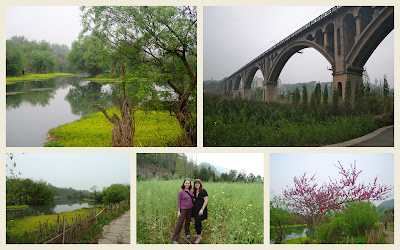The students also LOVE competing against one another. With roughly 50 students per class, I usually break them into four teams of 10-12 and see which team is the best. It's usually the team that's the loudest and proudest but I upped the ante by telling them that the best means they are using their "tracking finger" to follow along with what we are reading in the text. That way, I know they are looking at the words as they speak them and not repeating. When 50 kids are shouting at you, it's impossible to to tell who's saying what! It's no secret that the students are fascinated by Lizzy and me but if they gaze at us while we teach and merely repeat what we way, our time here will not be as valuable.
Lizzy's previous post did an awesome job of covering the details of how the school day works so I'll move on to our weekend expeditions.
On Friday, we took our first city busy for 1CNY, roughly $0.16! The price was right and now we'll have to practice memorizing our stop's characters. Lizzy photographed the bust stop so we have that as a reference for future bus adventures.
We're on a bus! The characters in red are our stop on Route 30.
The bus dropped us near Yangming Temple. Wang Yangming (1472-1529) was an educator and philosopher during the Ming Dynasty. He is famous for being a Neo-Confucian idealist who developed the idea of Innate Knowing or the belief that everyone is born knowing the difference between good and evil and distinguishing between the two is instinctive, no rational thought required.
The temple to honor Yangming was built long after his death and the grounds are unbelievable. A sprawling campus of buildings housing ancient calligraphy, paintings, texts and statues; we explored every nook and cranny.
All in all, Friday was another inspiring day in Guiyang filled with beauty and mystery.
On Saturday, we rented bikes and pedaled around Huaxi Park (Flower Stream Park) in the Huaxi District of Guiyang.
This scenic area follows the Flowery River and we visited at the perfect time as many of the flowers were blooming. The park was originally built during the Qing Dynasy (1644-1911) and rebuilt in the 1930's.
Baibu Bridge in Huaxi Park
Due to a little rainstorm, we did not get to walk across the Baibu Bridge but since we now know that Huaxi Park is only a 30 minute cab ride, we will hopefully return one day and walk on water.
As if Friday and Saturday weren't interesting enough, we decided it was time to head back to Qianling Park and take a look at the famous Hongfu Temple. Most people hike up the mountain (and we will next time) but we only had a couple of hours and our curiosity had the best of us so we opted to take the lift up to the top.
The lift provided stunning views of Guiyang.
The Hongfu Temple is the most famous Buddhist Temple in Guizhou Province. The temple, founded by Monk Chisong in 1672 (Qing Dynasty), began as a modest hut. Monk Chisong believed the site should be developed into a treasured shrine and with his persistence, he convinced local officials to support expansion of the site. It was given the name "Hongfu," a Chinese word meaning, "To develop Buddha's spirit and to benefit mankind" or, "Good Fortune." (I found two different translations and will ask a local which is correct, stay tuned!) Over the years, the temple grounds have been rebuilt and restored. Today, Hongfu Temple stands as a series of majestic halls and peaceful grounds overlooking the bustling city of Guiyang.
Buddhism is the fourth largest religion in the world. Founded in India about 2,500 years ago, it is the dominant religion in the Far East with over 360 million followers. Buddhist beliefs can vary but all have the common themes of ending suffering, the cycle of rebirth, admiration of the figure, Buddha (the awakened one) and Karma.
At the temple, we observed people lighting incense, bowing and praying before the magnificent statues. Lizzy and I did not partake on this particular day. We were short on time and I think it's appropriate to wait until we walk up the mountain to participate in the Buddhist rituals.
A few considerations for visiting a Buddhist temple:
- As with any religious site, dress appropriately. Shoulders and knees must be covered.
- Shoes are typically removed outside the temple. Look for a pile of shoes.
- Take care to ensure your feet are never pointed at a Buddha or relic when kneeling or sitting.
- Keep your head BELOW Buddha statues, images, honorable Monks and Nuns.
- Visitors may participate in lighting incense or other observed activities. It is also an option to simply sit and take it all in, finding your own spiritual connection.
- Visitors are welcome to wander about the grounds but be sure to show respect for worshipers.
- Check to make sure photography is permitted within temple halls.
- Small monetary contributions are welcomed to support the religious community.
Lizzy and I are looking forward to hiking up the mountain. I highly recommend visiting the tranquil grounds of Hongfu Temple. You'll find it a welcomed respite from the hustle and bustle of city life in Guiyang.
Travel tips:
- As with visiting any religious site, dress appropriately. Shoulders and knees should be covered.
- The iPhone (or any other SmartPhone) is a valuable resource. The camera can take photos of signs you'll need to remember and there are several Apps available for translating.
Natalie















Ohhh!!!
ReplyDeleteHongfu Temple looks very nice. The views from the cable car are very cool.
Good post! I like the tidbits of info. It'll come in handy one day when I visit China (on my bucket list)
ReplyDeleteThanks Jeff!!! You will love China. The photography opportunities are endless!
ReplyDelete